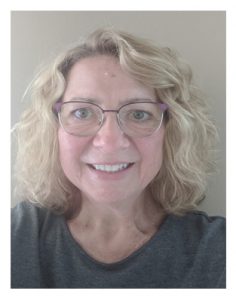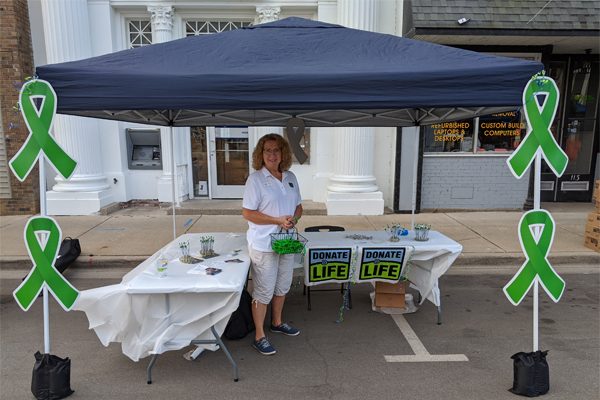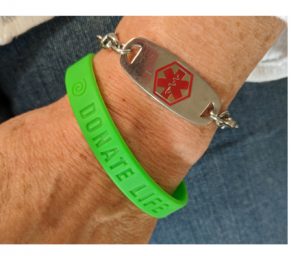Diane Wilkie now gives of her time manning booths for Gift of Life Michigan. She is holding a basket of “Donate Life” awareness bracelets that she gave to people visiting her booth at Grass Lake’s recent Heritage Day.
By John Hummer
Editor
 Diane Wilkie (pictured left) and her husband, Alan, of Jackson, were manning a booth during Grass Lake’s Heritage Day in September for Gift of Life Michigan. Diane volunteers for the organization because she was the recipient of a gift of life in 2014. Diane, a lifelong resident of Jackson, received a liver from a donor who had passed away who was a registered organ donor. Ironically, Diane was also able to donate her liver to a person needing one later that same night.
Diane Wilkie (pictured left) and her husband, Alan, of Jackson, were manning a booth during Grass Lake’s Heritage Day in September for Gift of Life Michigan. Diane volunteers for the organization because she was the recipient of a gift of life in 2014. Diane, a lifelong resident of Jackson, received a liver from a donor who had passed away who was a registered organ donor. Ironically, Diane was also able to donate her liver to a person needing one later that same night.
Diane’s family has a rare disease that can be passed down through the generations called familial, or hereditary, amyloidosis. It often affects the liver, nerves, heart, and kidneys. In Diane’s case, it was her liver.
“It’s very common to go to a doctor and have them say, ‘I’ve heard of it but I don’t know what it is,’” she said.
Diane’s father was diagnosed with amyloidosis when he was in his late 40s, which was in the 1960s, she noted. “He ended up in a skilled nursing facility and died in 1970 when he was 54 years old. It was horrible.” At the time of his death, they didn’t know the disease was hereditary.
Fast forward to late 2012 and early 2013 when Diane’s brother, Doug Walz, who is four years older than her, started having heart problems. After undergoing some genetic testing, he received a diagnosis from the University of Michigan Hospital that he had amyloidosis. “Symptoms typically begin when you’re in your 50s,” Diane explained. Her brother did some research on the disease and found out that Mayo Clinic, in Rochester, Minn., studies the disease. “They have a whole team of doctors from all different areas that study our disease,” she said.
Doug began having appointments at Mayo and called Diane and her sister and advised them that they needed to have genetic testing done. They took him up on it and had the testing done at U of M. They both tested positive for the disease, yet neither of them exhibited any symptoms at the time. Thinking preventatively, they contacted Mayo Clinic who invited them out for further testing.
“It was January of 2014 that I first went to Mayo Clinic for the confirmation of the diagnosis and to see whether I had any symptoms that were unknown to me at that point,” Diane recalled.
Diane explained that amyloid is a protein that is created in the liver. “The liver is not diseased, it is just over-producing this protein because of this mutation,” she noted. “That sticky protein called amyloid can glob onto any other organ in your body. In our case, it sticks to the walls of our heart. It builds up with this sticky substance and makes it so the heart can’t expand and contract, meaning it eventually won’t be able to pump anymore. So, your symptoms become shortness of breath and weakness because your heart is not pumping normally.”
Mayo Clinic ran the testing on Diane over the course of 2014 and did a heart biopsy. They discovered that she already had a little bit of thickening on the walls of her heart. Because there is no cure for the disease, the team at Mayo offered to do a liver transplant for Diane.
The object of the transplant was to put a normal-producing liver in. “In 80 percent of patients, that will stop the disease where it is at that time,” she stated. She calculated that the 80 percent chance of not getting any worse was worth the risk and signed up for a liver transplant. (More below)
“That was weird knowing that I’m going to have this life-changing surgery – because it is life-changing – your lifestyle is different afterward,” Diane says.
Diane was put on the transplant list in July of 2014, and she got her new liver in November of 2014. Typically, the wait is a year to a year-and-a-half. “It was incredible,” she exclaimed.
However, “Once you’re on the transplant list, you have to be ready to go. You have to know that you can get there within 10 hours.” Diane and her husband Alan had arranged with Charter Flight Services to be on standby where the company would have a plane ready when Diane called them. “We spent that summer and fall staying close to home because we had to be ready to go on a moment’s notice,” she said. Diane was still working full time as well while waiting for the call, which finally came on Nov. 14, 2014. “Of course, the call came at 1 o’clock in the morning, because everything happens in the middle of the night, right?
The chartered flight picked Diane and Alan up at the Jackson airport and they arrived in Rochester, Minn. at 6 a.m. Diane’s transplant surgery began later that morning and lasted eight hours. She was in the hospital for eight days. Following her release, she had to remain in Rochester for about three more weeks for follow-up appointments, tests, and to ensure everything was healing properly.
So how do they know it was the right liver to be transplanted into Diane? The three main things doctors look for in the match are blood type, tissue type, and body size. Diane actually received a man’s liver. The man had had an aneurism.
Information on the donor isn’t given out freely. The person receiving the organ can write a letter to the donor family, which is sent to the transplant administrative personnel. They, in turn, contact the donor family informing them that they have a letter from the organ recipient. “They have the opportunity to say ‘yes’ or ‘no’. If they say ‘yes,’ it’s mailed on to them. If they say ‘no,’ it’s sent back to the organ recipient. “The donor family did accept my letter and his wife wrote back to me,” Diane noted. “I got a very nice letter back with a picture of him and some other information about him. That was incredible to know that.” The donor happened to be from Minnesota.
At three months after the surgery, Diane went back to Mayo for a check-up and was cleared to go back to work half-days. After a month of half-days, she went back to work full-time in March of 2015. She is now retired.
To this day, Diane says she is feeling “perfect”. She takes immuno-suppressant anti-rejection medication daily to keep her body from rejecting the new liver. That is standard procedure for people that receive transplanted organs.
Receiving her new liver has definitely changed Diane’s outlook on life. “I appreciate every single day,” she says. “I just feel so blessed. So many people have been so kind to me. Every day is a new chance to have another wonderful day. I just appreciate everything more. If I hadn’t gotten my transplant – at this point, at age 64 – I would probably already be dead. That’s a wake-up call every day, and it has been since the transplant. It’s bonus time for me. Every day is a bonus.”
In her newly retired life, Diane enjoys spending a lot of time in her garden during the summer. “I spend a lot of time watering and weeding my flowers,” she says. She and Alan enjoy going to garage sales together and making day trips to Lake Michigan.
Nearly a year later, Diane’s brother received a heart and liver transplant on Sept. 30, 2015. “He just went for his check-up a couple of weeks ago and he is doing great,” she said.
Upon retirement in May of 2019, one of Diane’s goals was to spread the word about organ donation. One of the first things she did was to go through volunteer training with Gift of Life Michigan (GOLM), the organization that maintains the organ donor registry in Michigan. GOLM’s main mission is to make people aware of organ donation, how it can improve and extend others’ lives, and get them to sign up.
Diane received her volunteer certification from GOLM in the fall of 2019. Due to COVID, she really didn’t get an opportunity to do volunteer work until Heritage Day (the weekend after Labor Day) in Grass Lake. “I just had a blast,” she said. “I had so much fun talking to people and hearing their stories.” She was also amazed how many people were already organ donors. She got five new people registered that day.
“It’s not automatic – you have to sign up and say ‘I want to donate my organs,’” Diane says. That’s not true everywhere. In some states, a person is automatically a donor unless he or she opts out. In Michigan, when renewing or getting a driver’s license, a donor has to “opt-in” for donating certain organs of their body, or all organs. If not done through a driver’s license, a potential donor can join the Donor Registry online. (See the end of the story for the online link.)
Organs that can be donated generally include the heart, kidneys, liver, lungs, pancreas, intestines, corneas, and tissue (including tendons, skin, and bones). One person can donate up to eight life-saving organs, as well as tissue and corneas that can drastically improve the lives of another 75 people.
Gift of Life Michigan, one of many organizations that register organ donors, is connected to and part of the network called United Network for Organ Sharing (UNOS). UNOS is a nonprofit organization that administers the only organ procurement and transplantation network in the United States, established by the U.S. Congress in 1984. The organization will help match organ donors with organ recipients on a national and regional basis.
There are currently more than 106,000 people on the national organ transplant waiting list and the 1.75 million Americans who receive tissue transplants annually. Although the generosity of deceased donors saves more than 90 lives each day, the need for organ transplants is outpacing the rate of donor registrations. According to Donate Life America, someone is added to the waiting list every 10 minutes. Because of this, it is critical that everyone who supports organ donation takes the time to register as an organ donor. It can be done in about a minute online. (See the end of the story for the link.)
What happened with Diane’s liver?
Diane’s liver was actually a healthy liver; it just over-produced the amyloid protein. That enabled doctors to do what is called a “domino transplant” in which Diane’s liver could be donated to someone else.
There were several criteria for someone to have been able to receive Diane’s liver. First, they had to be over 60 years of age because they’re typically not going to live long enough to live another 50 years to have any symptoms. Second, they pretty much have to be sick enough to be taken off the regular liver transplant list.
“Another gentleman got my liver after they took it out of me that same night at Mayo,” Diane stated. “Just by having conversations in the liver unit the week following the transplant, he and I and our spouses put two and two together and figured out that he got my liver.”
Now, every year when Diane goes out to the Mayo Clinic for her check-up, she and Alan, and her liver transplant recipient, named Jim, and his wife have dinner together. “It’s been seven years now and he’s doing really well with my liver,” Diane says proudly. “That’s the most incredible part of the story to me – that I was able to help someone else.” Jim is now 67 – he was 60 when he received Diane’s liver.
Surprisingly, Diane said, Jim’s doctors had told him prior to his liver transplant that he had about six weeks to live. “When he got my liver, he was at eight weeks, so he had already lived longer than they anticipated he would because of his illness. Now he’s had another seven years. He’s a farmer – he still goes out on the tractor and helps around the farm.” (More below)
What you can do to help others with the Gift of Life
There are several ways you can help Gift of Life Michigan accomplish its mission. Besides registering to be an organ donor, visit their website to make a financial contribution and/or sign up to volunteer your time with GOLM, such as working booths at events. If going to events and interacting with the public isn’t your cup of tea, learn about GOLM’s comfort blanket program where you can make and donate blankets to donor families.
For more information, contact Kim Zasa, volunteer coordinator for Gift of Life Michigan at 734-922-1042, kzasa@golm.org; or visit the organization’s website at giftoflifemichigan.org. There you can sign up to receive the GOLM newsletter. Financial contributors can do so via the website or mail checks to Gift of Life Michigan, 3861 Research Park Drive, Ann Arbor, MI 48108-2217.
Want to register to be an organ donor? Visit giftoflifemichigan.org/become-a-donor.








